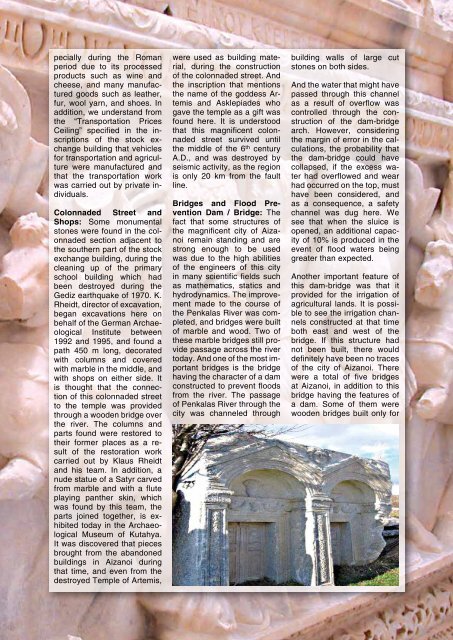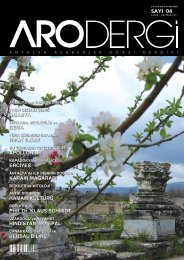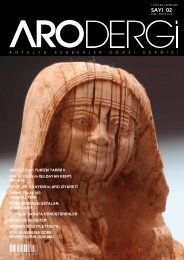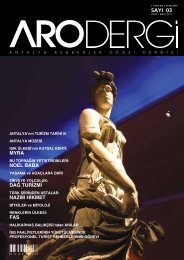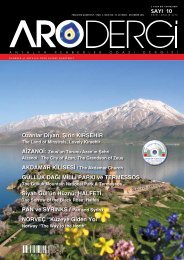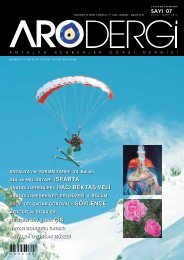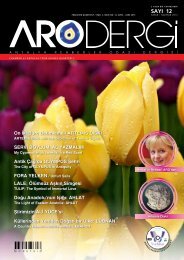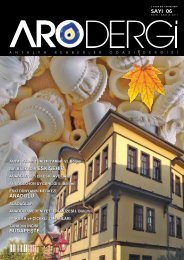Sayı 11- Ocak/Mart 2013 - Antalya Rehberler Odası
Sayı 11- Ocak/Mart 2013 - Antalya Rehberler Odası
Sayı 11- Ocak/Mart 2013 - Antalya Rehberler Odası
- No tags were found...
You also want an ePaper? Increase the reach of your titles
YUMPU automatically turns print PDFs into web optimized ePapers that Google loves.
pecially during the Romanperiod due to its processedproducts such as wine andcheese, and many manufacturedgoods such as leather,fur, wool yarn, and shoes. Inaddition, we understand fromthe “Transportation PricesCeiling” specified in the inscriptionsof the stock exchangebuilding that vehiclesfor transportation and agriculturewere manufactured andthat the transportation workwas carried out by private individuals.Colonnaded Street andShops: Some monumentalstones were found in the colonnadedsection adjacent tothe southern part of the stockexchange building, during thecleaning up of the primaryschool building which hadbeen destroyed during theGediz earthquake of 1970. K.Rheidt, director of excavation,began excavations here onbehalf of the German ArchaeologicalInstitute between1992 and 1995, and found apath 450 m long, decoratedwith columns and coveredwith marble in the middle, andwith shops on either side. Itis thought that the connectionof this colonnaded streetto the temple was providedthrough a wooden bridge overthe river. The columns andparts found were restored totheir former places as a resultof the restoration workcarried out by Klaus Rheidtand his team. In addition, anude statue of a Satyr carvedfrom marble and with a fluteplaying panther skin, whichwas found by this team, theparts joined together, is exhibitedtoday in the ArchaeologicalMuseum of Kutahya.It was discovered that piecesbrought from the abandonedbuildings in Aizanoi duringthat time, and even from thedestroyed Temple of Artemis,were used as building material,during the constructionof the colonnaded street. Andthe inscription that mentionsthe name of the goddess Artemisand Asklepiades whogave the temple as a gift wasfound here. It is understoodthat this magnificent colonnadedstreet survived untilthe middle of the 6 th centuryA.D., and was destroyed byseismic activity, as the regionis only 20 km from the faultline.Bridges and Flood PreventionDam / Bridge: Thefact that some structures ofthe magnificent city of Aizanoiremain standing and arestrong enough to be usedwas due to the high abilitiesof the engineers of this cityin many scientific fields suchas mathematics, statics andhydrodynamics. The improvementmade to the course ofthe Penkalas River was completed,and bridges were builtof marble and wood. Two ofthese marble bridges still providepassage across the rivertoday. And one of the most importantbridges is the bridgehaving the character of a damconstructed to prevent floodsfrom the river. The passageof Penkalas River through thecity was channeled throughbuilding walls of large cutstones on both sides.And the water that might havepassed through this channelas a result of overflow wascontrolled through the constructionof the dam-bridgearch. However, consideringthe margin of error in the calculations,the probability thatthe dam-bridge could havecollapsed, if the excess waterhad overflowed and wearhad occurred on the top, musthave been considered, andas a consequence, a safetychannel was dug here. Wesee that when the sluice isopened, an additional capacityof 10% is produced in theevent of flood waters beinggreater than expected.Another important feature ofthis dam-bridge was that itprovided for the irrigation ofagricultural lands. It is possibleto see the irrigation channelsconstructed at that timeboth east and west of thebridge. If this structure hadnot been built, there woulddefinitely have been no tracesof the city of Aizanoi. Therewere a total of five bridgesat Aizanoi, in addition to thisbridge having the features ofa dam. Some of them werewooden bridges built only for


